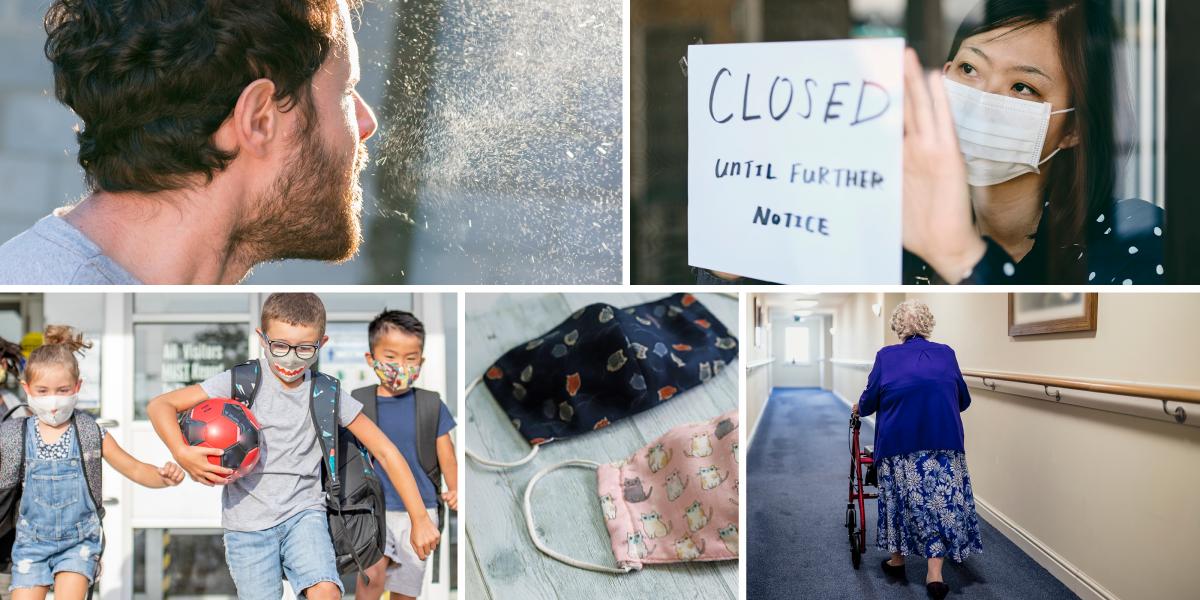Our Evolving COVID-19 Response
Four things we’ve learned since the beginning of the pandemic—and one we expected but failed to get right.
When SARS-CoV-2 first emerged, public health experts had to respond even before knowing how the virus spread or how best to contain it. Their understanding of the virus and subsequent guidance for the public have evolved throughout 2020.
Here, we look at four areas where experts have grappled with new information about the virus to refine our response, as well as one thing experts were right about early on—that the U.S. still struggles to address.
Airborne Transmission
Where we started: SARS-CoV-2 spreads through respiratory droplets and contaminated surfaces. Initial precautions emphasized disinfecting surfaces and social distancing.
Where we are now: It is now recognized that SARS-CoV-2 can also spread through airborne viral particles. Guidance now also emphasizes mask wearing.
How we got here: Early on, aerosol scientists like Ana María Rule, PhD ’05, MHS ’98, and Kirsten Koehler, PhD, MS, suggested that SARS-CoV-2 could be airborne, meaning that some viral particles can hang suspended in the air for a period of time.
“If someone in the room is carrying [the] disease, this poses a potential route of exposure for anyone else breathing in that same air,” Koehler said.
But it wasn’t until July—after more than 200 scientists published an open letter—that the WHO recognized the airborne potential of SARS-CoV-2. The CDC updated their guidance in October.
“I honestly don’t know—and cannot understand—why it took the WHO and CDC so long to change their recommendations. The science is pretty clear,” Rule said.
Masks
Where we started: Masks protect others if we are sick, but may not protect us.
Where we are now: There is now more evidence that masks reduce both transmission and possibly severity of disease for wearers.
How we got here: As more people have begun wearing masks when spending time outside the home, there is emerging evidence that mask use may also reduce the severity of infection.
A July study in the Journal of General Internal Medicine suggested that universal masking could reduce the amount of virus in the air, which could lead to milder or even asymptomatic infections.
“We have known for more than 50 years that lower inoculums of other viruses, including flu, lead to milder illnesses,” said study co-author and epidemiologist Chris Beyrer, MD, MPH ’91. “Since this is a basic principle in virology, it likely holds true for COVID-19.”
Shutdowns
Where we started: Shutdowns work to flatten the curve so other prevention approaches can be ramped up.
Where we are now: Shutdowns can flatten the curve, but if other approaches aren't also implemented, outbreaks simply rebound as restrictions are eased.
How we got here: Shutdowns are a dramatic option in a pandemic and are used to urgently slow transmission and prevent hospitals from becoming overwhelmed. They are disruptive, isolating, and can be traumatic—but they can decrease transmission opportunities and limit the spread of disease.
“Shutdowns are a last resort, but sometimes there are so many cases that urgent action is needed to break chains of transmission and slow the outbreak down,” says epidemiologist Caitlin Rivers, PhD, MPH.
“The goal is to bring down levels of community transmission—ideally to levels that could be managed through contact tracing and supported isolation and quarantine,” Rivers says. But without other approaches to managing transmission, the outbreak will rebound when restrictions are eased.
This is evident in the U.S., where the virus began spreading more intensely when jurisdictions reopened without building up testing and contact tracing capacity.
Children and COVID
Where we started: Children are largely unaffected by COVID-19.
Where we are now: Children can become infected and transmit SARS-CoV-2, but we don’t know to what degree. Some can become critically ill—and we still don’t know why.
How we got here: Early in the pandemic, a study from China suggested that children were infected just as much as other age groups but were more likely to remain asymptomatic.
In late April, however, reports surfaced of a rare and dangerous condition called multisystem inflammatory syndrome in children, or MIS-C.
An affected child’s immune response would go into overdrive, triggering “a cascade of events that attacks their organs and presents in multisystem organ failure,” said Johns Hopkins pediatric cardiologist Laysa Gaur, MD. Experts still don’t know what causes the complication in some children and not others, and the CDC now says that adults can get a form of MIS-C as well.
The One We Expected: Congregate Settings
Where we started: Congregate settings like nursing homes, prisons, and colleges are especially vulnerable to infectious disease outbreaks.
Where we are now: Some of the largest clusters of COVID-19 cases and deaths in the U.S. occurred in these settings—and outbreaks continue.
How we got here: Some of the first U.S. COVID-19 cases were traced to a long-term care facility in Washington state. As of early October, there have been over 240,000 cases among LTCF residents and more than 58,000 deaths.
Early on, Chris Beyrer flagged this potential for catastrophic outbreaks in America’s packed prisons. By July, more than five of the 10 largest clusters of COVID cases were in prisons and jails.
And we’re still trying to get this right: Colleges and universities can move some or all services online. Beyrer has called for de-densification of prisons. The Center for Health Security has issued guidance for the criminal justice system, LTCFs, and colleges. And experts Emily Gurley, PhD ’12, MPH, and Tolbert Nyenswah, MPH ’12, have laid out suggestions for robust contact tracing on college campuses.





